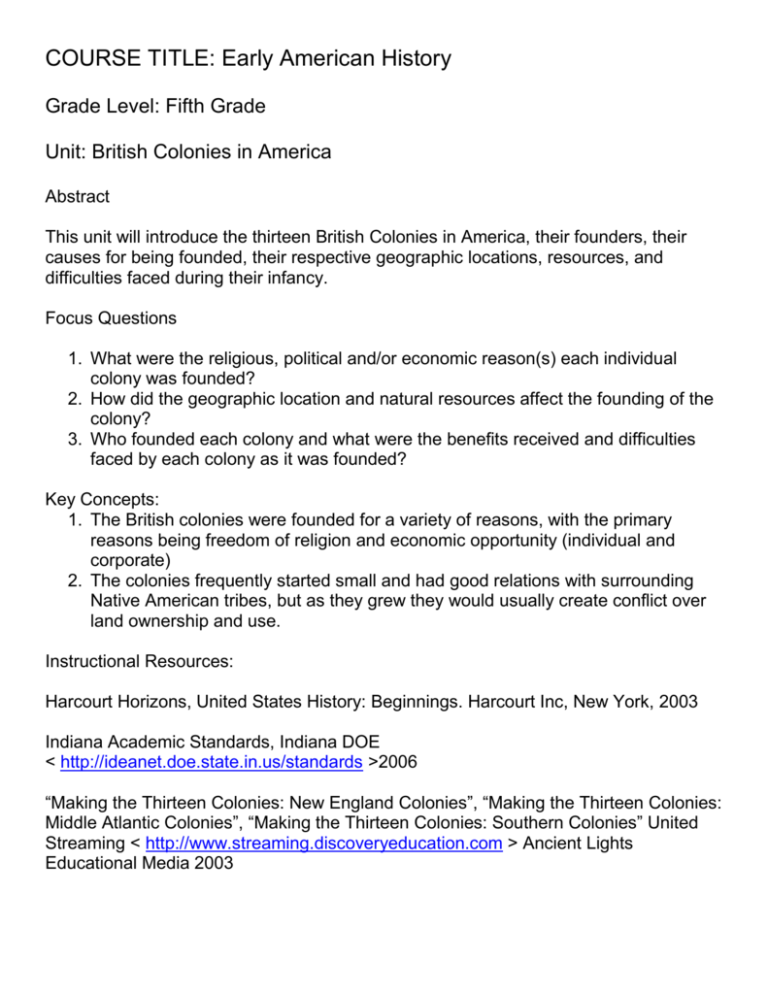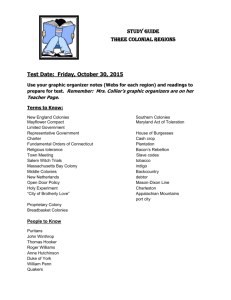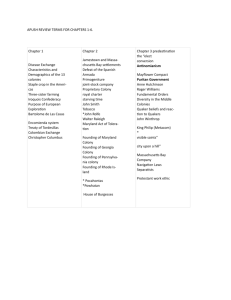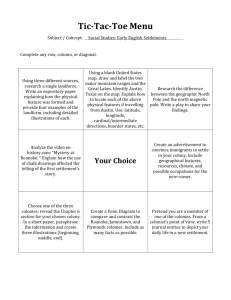British Colonies in America, Course Title: Early American History
advertisement

COURSE TITLE: Early American History Grade Level: Fifth Grade Unit: British Colonies in America Abstract This unit will introduce the thirteen British Colonies in America, their founders, their causes for being founded, their respective geographic locations, resources, and difficulties faced during their infancy. Focus Questions 1. What were the religious, political and/or economic reason(s) each individual colony was founded? 2. How did the geographic location and natural resources affect the founding of the colony? 3. Who founded each colony and what were the benefits received and difficulties faced by each colony as it was founded? Key Concepts: 1. The British colonies were founded for a variety of reasons, with the primary reasons being freedom of religion and economic opportunity (individual and corporate) 2. The colonies frequently started small and had good relations with surrounding Native American tribes, but as they grew they would usually create conflict over land ownership and use. Instructional Resources: Harcourt Horizons, United States History: Beginnings. Harcourt Inc, New York, 2003 Indiana Academic Standards, Indiana DOE < http://ideanet.doe.state.in.us/standards >2006 “Making the Thirteen Colonies: New England Colonies”, “Making the Thirteen Colonies: Middle Atlantic Colonies”, “Making the Thirteen Colonies: Southern Colonies” United Streaming < http://www.streaming.discoveryeducation.com > Ancient Lights Educational Media 2003 Benchmarks Assessment Tasks Key Concepts Students will: • explain the religious, political, and economic reasons for movement of people from Europe to America. (SS 5.1.5) • Identify and discuss instances of both cooperation and conflict between Native American Indians and European settlers, such as agriculture, trade, cultural exchanges and military alliances, as well as later broken treaties, massacres and conflicts over control of the land. (SS 5.1.6) • Identify and locate the 13 British colonies that became the United States and describe daily life. (SS 5.1.7) • Identify the early founders of colonial settlements and describe early colonial resistance to British rule. (SS 5.1.8) • Identify and explain ideas about limited government*, the rule of law and individual rights in key colonial era documents. (SS 5.2.2) • Give examples of how the British colonies in America developed forms of representative government, selfgovernment and democratic practices. (SS 5.2.3) • Explain how the Spanish, British and French colonists altered the character and use of land in early America. (SS 5.3.8) • Identify the major manufacturing and agricultural regions in colonial America and cite ways that agriculture and manufacturing changed between 1600 and 1800. (SS 5.3.9) • Using historical maps; locate and explain the conflict over the use of land by Native American Indians and the European colonists. (SS 5.3.10) Students will: 1. Draw a map containing the 13 colonies, their capitol, and showing natural resources and surrounding Native American tribes. (SS 5.1.6, 5.1.7, 5.3.8, 5.3.9, 5.3.10) • Historical Knowledge • Colonization and Settlement •Foundations of Government • Geography 2. Create a Comparison Chart of the colonies Including: •reasons for founding •basic framework of Government •Founder • general location (NE,MA,S) • benefits •difficulties •relations with surrounding people groups (SS 5.1.5, 5.1.6, 5.1.7, 5.1.8) 3. Write an advertisement as someone who is trying to gather people to start a colony in the New World. (SS 5.5.1.5, 5.1.7, 5.3.8) 4. Draw a theoretical colony including an explanation of the setting and factors affecting the survival of the colony. (SS 5.1.5, 5.3.8) 5. Write a proposition to be read at a town meeting on the form of local government you should have while addressing the possible opposition. (SS 5.1.8, 5.2.2, 5.2.3) • Human Systems Primary Assessments: Pretest: Identification of 13 original colonies and geographic locations and identification of primary reasons for immigration to the new world. Comparison Chart of 13 colonies: Students will create a chart including; founders and causes, location and resources, relationships with other colonies and Native American tribes, and any difficulties or advantages they had during colonial infancy. Colony Creation: Students will draw a fictional colony located ‘within’ the confines of the British Colonies in America. They will describe what group of people they will be bringing over from Europe, why they are immigrating, what they are looking for in a site to build a colony, how the colony will be governed, what their colony will be doing economically to grow and prosper, and how they will interact with the Native Americans in the area. Posttest: Students will take a test over the thirteen colonies composed of multiple choice, matching, short answer, and essay style questions. Catalog of Lessons: Pre Lesson: The New World Students will receive a blank map of the thirteen colonies. Lesson 1: Why New England Introduce N.E. Colonies, specifically Plymouth and then the Mass. Bay Colony. Teacher led discussion connecting early settlements with future colonies. Highlight freedom of religion as a primary reason for immigration. Compare religious restrictions in England to those in New England. Watch video “Making the Thirteen Colonies: New England Colonies.” Lesson 2: Why Not New England In small groups discuss the hardships that Plymouth and the Mass. Bay Colony faced. As a class, discuss how the relationship between colonists and Native Americans changed from friendship to animosity. Evaluate the decision to move to New England from comparative safety of England. Discuss why historical figures such as Roger Williams and Anne Hutchison (etc.) wound up leaving the Mass Bay Colony. Lesson 3: New England Patriots Using the book, students will research individual colonies (finding data for the chart) then share in groups of five, one student sharing each colony for the group. Lesson 4: Why Southern Colonies Introduce Southern Colonies, short teacher led discussion connecting the European colony movement for land and resources with the Virginia colonies and the growth of the Southern Colonies. Students will compare/contrast the climate conditions and crops in Southern Colonies to England. Highlight Economic Opportunity as a primary reason for immigration. Watch video “Making the Thirteen Colonies: Southern Colonies.” Lesson 5: Southern Struggle As a class, discuss the hardships that Roanoke and Jamestown faced. Discuss the interactions with Native Americans. Evaluate the resources available to the southern colonies and the impact of tobacco on Virginia and European trade. Lesson 6: Southern Style Briefly introduce Agriculture as the primary economic activity, plantations, and the incorporation of slavery as a source of labor and revenue. Analyze the proximity of the Spanish colony and the safety of the colonists. Also understand that land possession was a concern of Spanish Florida and how Georgia helped to establish English land claims farther south limiting the growth of the Spanish colony. Lesson 7: Why the Middle Atlantic Introduce the Middle Atlantic as the gap between the Southern Colonies and the N.E. Colonies, evaluate why other countries settlements were in the way of expansion, and why possession of these lands was vital to England’s growth. Analyze how the growth of the N.E. colonies southward and the Southern Colonies northward, would inevitably bring conflict with New Sweden and New Netherland. Watch video “Making the Thirteen Colonies: Middle Atlantic Colonies.” Lesson 8: Good Bread In reading and research have the students determine what resources were available to the Middle Atlantic colonies and why they were also called the Breadbasket Colonies. Have each student research a colony, join a group with other colonies and discuss their colony and its strengths and weaknesses, founding history, and any other notable historical references that the group may find interesting. Lesson 9: Discuss the future of growth to the west. Bring into context the century + that the colonies were loyal subjects to the crown without major problems. How colonial life benefitted both the colonies and Britain. Recap the colonial development and review important facts, events, relationships to aide in retention for upcoming test. Provide time for completion of comparison chart for students of the 13 colonies. Finally: Look at conflict building between French, Indian, British, and Colonial interests (to connect the next topic of study to this.) Abstract: This task is to assess their manipulation of factual data to compare and contrast the thirteen colonies as they were created and started to develop. It will help prepare them for the post test as they find out facts and knowledge about the thirteen colonies and process that knowledge while turning it into a product that can be shared with others. Prompt: an example of colonial data that shows what important information they are to learn and remember will be show prior to the beginning of the projet. Directions: “The State of Indiana with its standards says that you must know certain information about the beginnings of the 13 original colonies. You will therefore create a chart of their own that shows the factual information answering the questions in the learning goals of this unit.” “You will include - The founder(s) and their reasons for founding the colony - A brief description of the location and resources of the colony - A brief description of how the colony interacted with other colonies and Native American groups around it. - Any difficulties or advantages the colony had that affected its survival Procedure: Prepare a blank chart page that will contain columns and rows for each piece of data to be included. Show the sample on the Smartboard and fill in a sample of a fictitious colony. Scoring Rubric for Comparison Chart of Colonies: Product Students will create a comparison chart of the 13 British Colonies in America. Score 1 Creates a chart with minimal information. Including few (<2) facts about each colony. 2 3 Creates a chart with less than adequate information. Including some (2-3) facts about each colony. Creates a chart with adequate information. Including (4-5) facts about each colony. 4 Creates a chart with detailed information. Including (6+) facts about each colony. Abstract: This task is designed to show the students understand and synthesis of the factual data about the British Colonies and for them to use that to create a realistic yet fictional colony of their own. Directions: “Students, you will be required to draw a map of their colony including geographical and resource information. You will diagram what buildings will be found in and around their colony. You will also write an explanation of your colony’s founding history including who founded it and why, where your colony is located and how this affected your colony’s resources. Furthermore, you will include a brief summary of your colony’s governance, economic conditions, and your relationships (and attitudes) with other populations surrounding their colony.” Procedure: Have each student draw a rough sketch of their colony, when the sketch is reasonable, give each student a piece of 12 by 18 white paper to draw the colony on. Also give each student a piece or three of lined paper to write their summaries on and a paperclip to join the two. Scoring Rubric for Colony Creation: Product Score 1 2 3 Map is of poor quality, Map is legible but Map is legible and Create a colony hard to read and missing many has all basic details map understand important details included Create a colony summary Summary is present but does not convey information Summary is present and contains some basic information Summary is well formed and includes all basic information 4 Map is of high quality and has more than basic details included Summary is well formed and includes lots of specific details






